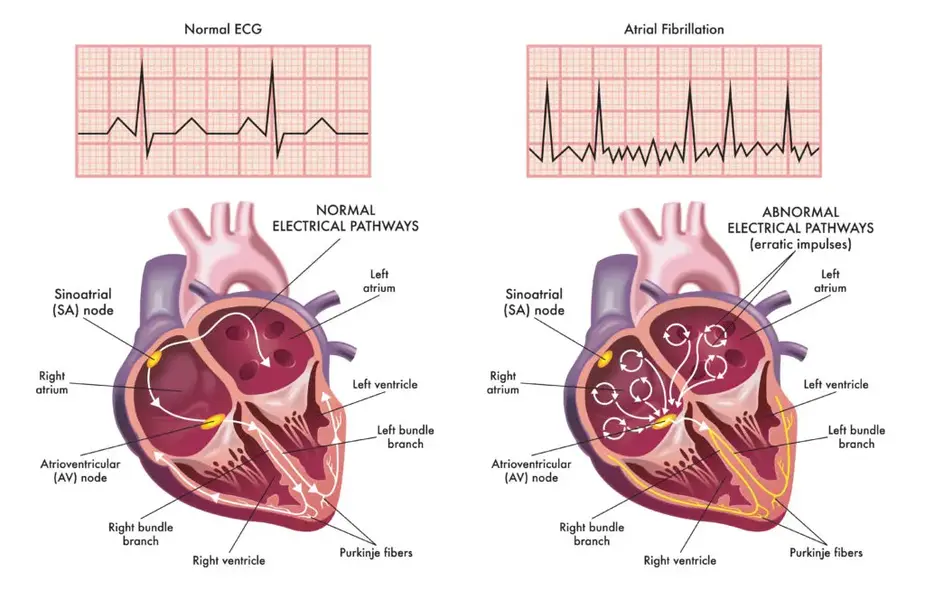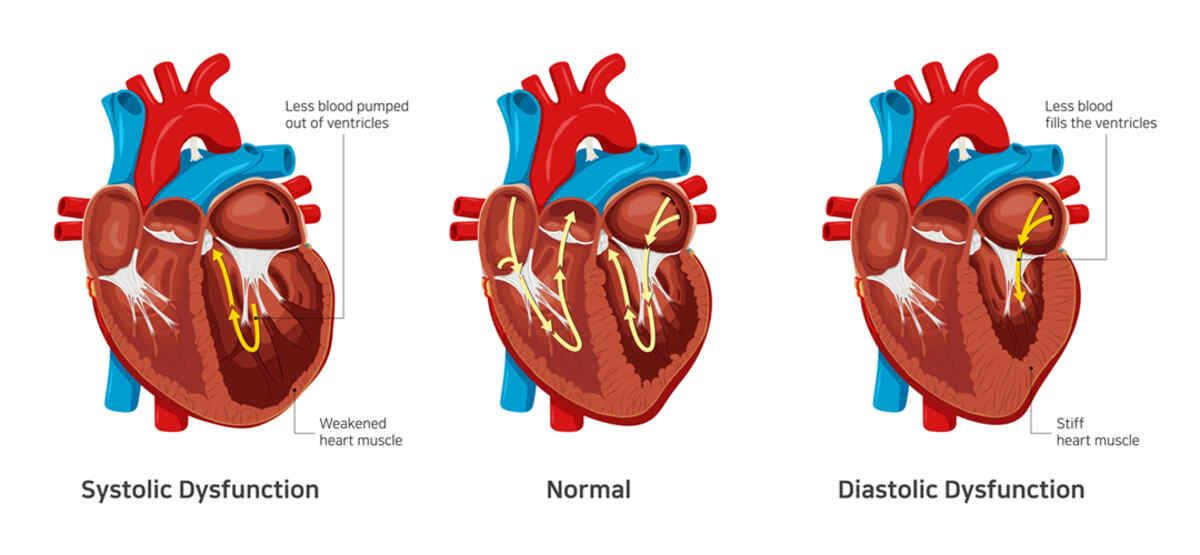Atrial Flutter vs. Atrial Fibrillation
Atrial flutter is a type of arrhythmia (irregular heartbeat) where the atria beat too fast but usually maintain a regular rhythm.
Atrial fibrillation (AFib) is another form of arrhythmia related to atrial flutter. However, in AFIB, the electrical signals in the heart are more disorganized, causing a fast and irregular heartbeat. This can lead to an abnormal ventricular rate and may impact heart health.
Both atrial flutter and Atrial Fibrillation (AFib) occur when the electrical signals controlling heartbeats happen faster than usual. The key difference lies in how these signals are organized.
Atrial flutter and AFib are common types of arrhythmias.
Please keep reading to explore their symptoms, causes, and treatments.
Which Heart Condition is More Serious: Atrial Flutter or Atrial Fibrillation?
Both atrial flutter and atrial fibrillation (AFib) can be severe, but many doctors consider atrial flutter to be less severe. This is because the symptoms of atrial flutter are often milder, and the risk of blood clot formation (embolization) is lower compared to AFib.
Additionally, in some patients, atrial flutter is more likely to return to a normal heart rhythm (sinus rhythm) on its own.
Are Atrial Flutter, Atrial Tachycardia, and Atrial Fibrillation the Same?
No, atrial flutter, atrial fibrillation (AFib), and atrial tachycardia are not the same. However, all three involve a fast heart rate that can often be felt as a rapid pulse.
Atrial tachycardia is a general term that refers to a fast and abnormal heart rate in the atria. It does not specify the exact type of irregular rhythm; only the heart rate is elevated. It is also called supraventricular tachycardia and can cause a rapid heartbeat even at rest.
In contrast, atrial flutter and AFib are specific types of atrial tachycardia. They differ in how the electrical signals in the atria behave:
- Atrial flutter has a more regular pattern of abnormal electrical activity.
- AFib has a chaotic and irregular pattern of electrical impulses.
Both atrial flutter and AFib are considered abnormal heart rhythms that can harm heart health and may negatively affect overall health.
Symptoms
Some people with atrial fibrillation (AFib) or atrial flutter may not experience any symptoms. When symptoms do occur, they are often similar for both conditions:
|
Symptom
|
Atrial fibrillation
|
Atrial flutter
|
|
Rapid pulse rate
|
Usually rapid
|
Usually rapid
|
|
Irregular pulse
|
Always irregular
|
Can be regular or irregular
|
|
Dizziness or fainting
|
Yes
|
Yes
|
|
Palpitations (feeling like the heart is racing or pounding)
|
Yes
|
Yes
|
|
Shortness of breath
|
Yes
|
Yes
|
|
Weakness or fatigue
|
Yes
|
Yes
|
|
Chest pain or tightness
|
Yes
|
Yes
|
|
Increased risk of blood clots and stroke
|
Yes
|
Yes
|
The key difference in symptoms is the regularity of the pulse. Atrial flutter often has a more regular rhythm and tends to cause less severe symptoms, with a lower risk of blood clots and stroke compared to AFib.
What Happens in Atrial Fibrillation (AFib)?
In atrial fibrillation (AFib), the upper chambers of the heart (atria) receive disorganized electrical signals. This causes the atria to beat out of sync with the lower chambers (ventricles), resulting in a rapid and irregular heart rhythm.
A regular heart rate is 60 to 100 beats per minute (bpm). In AFib, the heart rate often increases to 100 to 175 bpm.
What Happens in Atrial Flutter?
In atrial flutter, the upper chambers of the heart (atria) receive organized but faster-than-normal electrical signals. The atria may beat up to 300 times per minute, but only every second beat reaches the lower chambers (ventricles).
This results in a pulse rate of about 150 beats per minute. Atrial flutter produces a distinctive "sawtooth" pattern on an electrocardiogram (EKG), making it easier to identify.
How Do Atrial Flutter and AFib Differ in ECG Patterns?
Atrial Flutter ECG
Atrial flutter is a condition where the heart's upper chambers (atria) experience electrical conduction issues. These issues create a re-entry loop that causes the atria to beat rapidly, typically at 240–360 beats per minute (bpm).
In an electrocardiogram (ECG or EKG), atrial flutter appears as regular "sawtooth" P waves - small, successive waves with little to no intervals between them. This pattern is a key characteristic of atrial flutter.
Often, not all atrial beats pass through the AV node to the ventricles. This creates a 2:1, 3:1, or 4:1 conduction ratio, meaning the ventricles beat at a slower, more regular rate. The most common scenario is a 2:1 conduction, where the atria beat at 300 bpm, and the ventricles contract at 150 bpm.
In some cases, patients may experience bradycardia (a slow heart rate) because most of the atrial signals do not reach the ventricles. Atrial flutter waves can also appear and disappear spontaneously in specific individuals.
Atrial flutter is the second most common type of tachyarrhythmia.
AFib ECG
Atrial fibrillation (AFib) is the most common type of tachyarrhythmia, with an incidence of about 27–28 cases per 1,000 person-years.
In AFib, the heart's upper chambers (atria) experience chaotic electrical signals, leading to irregular conduction. On an electrocardiogram (ECG), this appears as irregular QRS waves with no P waves, unlike the "sawtooth" pattern seen in atrial flutter.
The irregular electrical signals often pass through the AV node to the ventricles, causing irregular and variable ventricular contractions. This irregular rhythm reduces the heart's ability to pump blood effectively. Ventricular contractions in AFib typically range from 100 to 175 beats per minute.
Causes of Atrial Flutter and AFib
The risk factors for atrial flutter and atrial fibrillation (AFib) are very similar:
|
Risk factor
|
Afib
|
Atrial flutter
|
|
Previous heart attacks
|
✓
|
✓
|
|
High blood pressure (hypertension)
|
✓
|
✓
|
|
Heart disease
|
✓
|
✓
|
|
Heart failure
|
✓
|
✓
|
|
Abnormal heart valves
|
✓
|
✓
|
|
Birth defects
|
✓
|
✓
|
|
Chronic lung disease
|
✓
|
✓
|
|
Recent heart surgery
|
✓
|
✓
|
|
Serious infections
|
✓
|
|
|
Misuse of alcohol or drugs
|
✓
|
✓
|
|
Overactive thyroid
|
✓
|
✓
|
|
Sleep apnea
|
✓
|
✓
|
|
Diabetes
|
✓
|
✓
|
People with a history of atrial flutter are at a higher risk of developing atrial fibrillation (AFib) in the future.
Treatment
The treatment goals for both AFib and atrial flutter are the same: to restore a normal heart rhythm and prevent blood clots. Treatment for both conditions may include:
Medications Include:
- Calcium channel blockers and beta-blockers to help regulate the heart rate
- Amiodarone, propafenone, and flecainide to restore normal heart rhythm
- Blood-thinning medications like non-vitamin K oral anticoagulants (NOACs) or warfarin (Coumadin) to reduce the risk of stroke or heart attack
Treatment Options
NOACs (Non-Vitamin K Oral Anticoagulants) are preferred over warfarin unless the person has moderate to severe mitral stenosis or an artificial heart valve. NOACs include dabigatran (Pradaxa), rivaroxaban (Xarelto), apixaban (Eliquis), and edoxaban (Savaysa).
- Electrical cardioversion: This procedure uses an electrical shock to reset the heart's rhythm.
- Catheter ablation: This procedure uses radiofrequency energy to destroy the area in the heart, causing an abnormal rhythm.
- Atrioventricular (AV) node ablation: This uses radio waves to destroy the AV node, which connects the atria and ventricles. A pacemaker is needed after this procedure to maintain a regular rhythm.
- Maze surgery: This open-heart surgery involves making minor cuts or burns in the atria of the heart to correct the rhythm.
Medication is typically the first treatment for AFib. However, ablation is often the most effective treatment for atrial flutter, usually reserved for cases where medications cannot control the condition.
Key Takeaway
Both AFib and atrial flutter involve faster-than-normal electrical impulses in the heart. However, there are a few key differences between the two conditions.
Main Differences
- In atrial flutter, the electrical impulses are organized, while in AFib, they are chaotic.
- AFib is more common than atrial flutter.
- Ablation therapy tends to be more successful in treating atrial flutter.
- On an ECG, atrial flutter shows a distinct "sawtooth" pattern, while AFib shows an irregular ventricular rate.
- The symptoms of atrial flutter are usually less severe than those of AFib.
- People with atrial flutter are at risk of developing AFib, even after treatment.
Both conditions increase the risk of stroke. Whether you have AFib or atrial flutter, early diagnosis is essential for receiving the proper treatment. contact Dr Deep Chandh Raja the best doctor for Atrial Fibrillation in Chennai to schedule an Appointment.




.jpg)